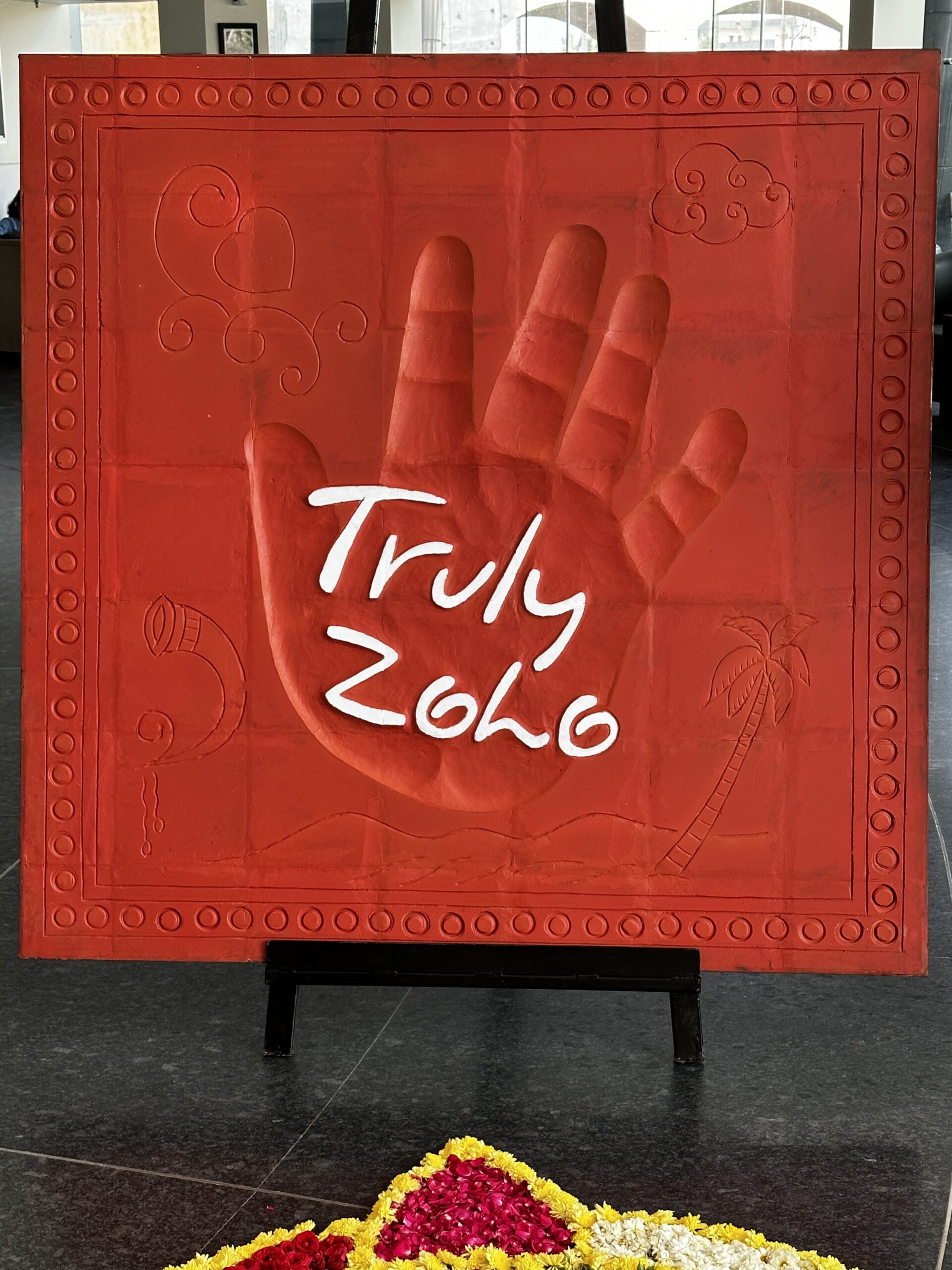
by twieberneit | Mar 21, 2023 | Blog, Case Study |
During the truly remarkable (pun definitely intended) TrulyZoho event I, of course had the chance to talk to some customers. One of these customers was Amit Rai of Tata Fiber, an Indian ISP. As the name suggests, Tata Fiber provides internet services through fiber. The company was founded in 2016 and started commercial rollout in 2018, so is a kind of start-up. Amit is the Chief HR Officer of Tata Fiber, but also led their digital projects and is now heading business development for the company. He happily agreed to a conversation about the relationship between Zoho and Tata. The following article is based on the conversation with Amit. TL&DR If you do not want to read and prefer a video, you can also listen in to the conversation. The original problem at hand We started in 2019 with HR management, in particular with Zoho people, as a solution in this functional area was needed. The implementation gave us confidence in Zoho and our implementation partner. From there on we implemented additional Zoho apps. We started on the call center as the agents needed to work with and toggling between a multitude of screens when working with a customer to resolve issues. The agents in parallel needed to talk to the customer, making sense. Of course, the quality of the conversations suffered from this and the conversations got longer. Longer conversations are a cost to us. Why Zoho? The original implementation gave us a good confidence in Zoho. This was not only because of the product but also because of the responses from the Zoho organization and the implementation team, the...

by twieberneit | Mar 2, 2023 | Blog |
The past 9 months have seen quite a rollercoaster in the tech industry. We have seen staggering profits, we continue to see stock buybacks, we have seen consolidation, mergers and acquisitions – and we have seen mass layoffs. Few of them were well handled or communicated. Even fewer showed any sign of executives taking accountability besides stating that they made mistakes during the pandemic and that they feel sorry for what they need to do now. They had simply over-hired and now need to take corrective action to stay on a ‘growth path’. One of these executives arguably took the prized company culture of regarding the employees as family to grave. What do these layoffs have in common? They were initiated to please the capital markets, i.e. shareholders and venture capitalists. The idea behind this is that layoffs is the fastest way to solve or avoid impending financial problems. However, there is mounting scientific evidence that this idea is a myth, as e.g., expressed here, here or here as summaries. There is often no financial benefit, even not after 3 years; instead, some scientists look at these layoffs as “the result of imitative behaviour [that is] not particularly evidence based” and that there are other, better ways that businesses can pursue. But, as Raju Vegesna says “customers are inherently loyal, employees are inherently loyal, investors are not. Yet, businesses are most loyal to this least loyal group of stakeholders”. Ouch! One of these better ways And, indeed, one company that pursues other avenues is Zoho. Zoho CEO and co-founder Sridhar Vembu pledged that there will be no layoffs for economic reasons, no matter what. But this isn’t...

by twieberneit | Jan 30, 2023 | Blog |
In 2022, the Forrester CX Index dropped for the first time in years, with nearly twenty percent of US brands seeing a drop in customer experience. Towards the second half of 2022, an increasing number of companies fear a recession and put their spending under scrutiny. At the same time, companies still struggle to link CX projects to business outcomes and their metrics, let alone to financial metrics. In addition, Forrester predicts that also in the next few years, CX teams will lack critical design, data and journey skills. In parallel, there is an increasing number of companies that deliver software and/or services that are intended to help businesses improve their CX. In the past years, CX has established itself as a whole new category of software. Many a company has repositioned itself to become a CX vendor, examples including all major CRM vendors, but also call center specialists like Genesys. And, naturally, a good number of these new CX actors got – and get – acquired by bigger fish. A very good example of this trend is the decrease in the number of independent journey orchestration vendors or the concentration of chatbot vendors into conversational AI vendors. Of course, this list cannot be exhaustive in any case. So, clearly vendors are betting big on CX being a growth market, while their clients still struggle to justify the expense into CX. This leads Forrester to predict that twenty percent of CX programs will be stopped and the teams correspondingly disbanded and probably be merged into other parts of the organization. Why is this? Although the true differentiator of every business nowadays is not product,...

by twieberneit | Jan 13, 2023 | Blog |
At the end of a year and the beginning of the following year all kinds of research organizations and pundits make their predictions. So could I but then, this year I choose to have a look at some predictions and comment on them. After all, there are predictions for all sorts of areas, including CX. So, what I’ll do instead is having a look at some them. I’ll analyse their rationale and give brief recommendations on what can be done to help work with them. This should be far more beneficial for you than me adding my own – probably redundant – predictions for 2023. So, here we go! These are my top three, along with some recommendations for enterprise software vendors and their customers. One in five CX programs will disappear One of the predictions of Forrester Research is that “one in five CX programs will disappear”. The good news is that at the same time one in ten will get stronger. This is largely, because businesses have not yet embedded CX into their business strategy. A second reason is that CX professionals still struggle with calculating and defending the ROI of a CX initiative. Sadly, Forrester is right. I agree and am actually a bit more pessimistic. Many business’s haven’t yet managed to tie the outcome of CX initiatives to business results. And at the end of the day, an expense needs to have a monetary consequence. This means, more revenue or less cost, more profitability. Being able to establish and defend this link is even more important in times where general uncertainty tightens budget strings. What to do as...

by twieberneit | Jan 9, 2023 | Blog |
Finally, it happened. We lived in our blissful world of an abundance of money that fuelled the illusion of eternal and unlimited growth. The stock markets knew only one direction for a decade. They were rising and rising. Venture capital was readily available. Valuations of all sorts of companies, profitable or not, skyrocketed. Growth at all cost over profitability has been the war cry. Acquisitions have been extremely expensive up to the end of 2021. Logic never supported this illusion, the signs have been on the wall, yet we closed our eyes. Then, in 2022, reality knocked at our doors, and none too subtle. In the “CX industry”, examples for this quite rude awakening include Zendesk. Zendesk went private in June 2022 for $10.2 bn after refusing a $16+ bn offer in February 2022. Another one is Freshworks shares starting a steep decline in October 2021 after a very successful IPO in September 2021. These are only two examples and I by no means want to single out these great companies. Other signs included an increasing number of major layoffs throughout the first half of 2022, culminating in Salesforce announcing more focus on profitability due to a subdued outlook and subsequently laying off 8 thousand employees. Oracle already laid off more than 10 thousand employees of its CX division in August 2022. Amazon fired 18 thousand employees since November, 2022. Especially companies in the tech industry increasingly implemented hiring freezes throughout 2022. This is to quite an extent a consequence of their optimism (or should we say hubris?) but also of companies across industries keeping their budgets in tighter control than before. Another problem is that the definition of customer experience...






